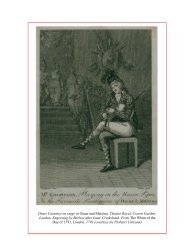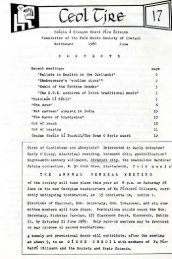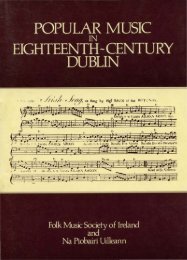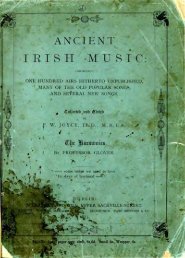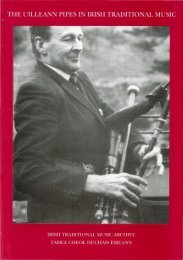NO 73 MERRION SQUARE, DUBLIN 2 - Irish Traditional Music Archive
NO 73 MERRION SQUARE, DUBLIN 2 - Irish Traditional Music Archive
NO 73 MERRION SQUARE, DUBLIN 2 - Irish Traditional Music Archive
You also want an ePaper? Increase the reach of your titles
YUMPU automatically turns print PDFs into web optimized ePapers that Google loves.
The Premises of the <strong>Irish</strong> <strong>Traditional</strong> <strong>Music</strong> <strong>Archive</strong> 13<br />
The Society for the Preservation and Publication of the Melodies of<br />
Ireland 1851<br />
Many of those prominently involved in the Society for the Preservation<br />
and Publication of the Melodies of Ireland, the first formal <strong>Irish</strong><br />
traditional music society, lived on Merrion Square or in its vicinity. The<br />
Society was established under the presidency of George Petrie in<br />
December 1851, in the aftermath of the Great Famine, to preserve, study<br />
and publish ‘the immense quantity of National <strong>Music</strong> still existing in<br />
Ireland’. 34 It was directed by a twenty-three-man Council. As well as<br />
David Richard Pigot and John Edward Pigot, Thomas Beatty MD and<br />
William Stokes MD lived on the Square, at nos 18 and 5 respectively. In<br />
the vicinity of the Square lived the Treasurer of the Society Robert<br />
Callwell (Herbert Place), its other joint Hon. Secretary Robert D. Lyons<br />
MD (Merrion Street), Rev. Charles Graves DD (Fitzwilliam Square),<br />
Benjamin Lee Guinness (Dawson Street), Thomas Rice Henn (Upper<br />
Mount Street), Henry Hudson and Samuel Maclean (St Stephen’s Green),<br />
Joseph Huband Smith (Holles Street), Rev. Jas. H. Todd (Trinity<br />
College), and William Wilde (later Sir William, father of Oscar; Westland<br />
Row). 35 Most of those associated with the Society were members of the<br />
Royal <strong>Irish</strong> Academy, which was then situated in Grafton Street.<br />
One of the aims of the Society, never realised, was ‘the formation of a<br />
central depôt in Dublin, to which persons... may be invited to send<br />
copies of any airs which they can obtain, either in Ireland or among our<br />
countrymen in other lands’. 36 The <strong>Irish</strong> <strong>Traditional</strong> <strong>Music</strong> <strong>Archive</strong> might<br />
be said to be a realisation of that aim. Its collections contain the<br />
published works of the Society and later editions of them.<br />
The Arts Council & Breandán Breathnach<br />
The Arts Council/ An Chomhairle Ealaíon, the <strong>Irish</strong> state’s development<br />
agency for the arts (including the traditional arts), has been based in no<br />
70 Merrion Square since 1959. In 1980 it appointed a <strong>Traditional</strong> <strong>Music</strong><br />
Officer for the first time, and it currently has a <strong>Traditional</strong> Arts section<br />
through which it funds traditional artists, projects, festivals, and arts<br />
organisations (including the ITMA) – see www.artscouncil.ie.<br />
From the early 1980s until his death, Breandán Breathnach (1912–85),<br />
the great expert on <strong>Irish</strong> traditional music whose personal collection is<br />
the foundation collection of the ITMA, had an office in the basement of<br />
no 70 in which he worked principally on his monumental index of <strong>Irish</strong><br />
traditional dance music. A member of the Arts Council from 1984, he<br />
chaired for it a committee on the establishment of a national archive of<br />
traditional music and was the author of its report.<br />
— Nicholas Carolan



